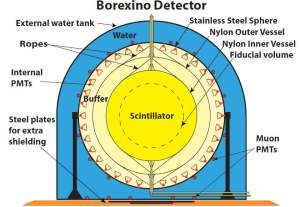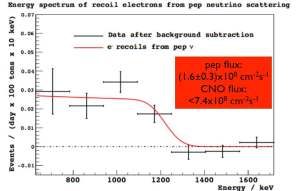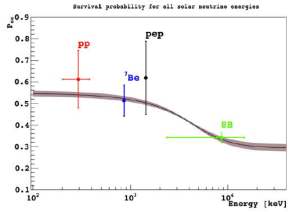At the XVI Neutrino Telescopes conference going on this week in Venice there was a nice presentation on the results of the Borexino experiment. The text below is a writeup of the highlights from the talk, given by Cristiano Galbiati from Princeton University. For other writeups from the conference see the conference blog.
The Borexino detector is located in the Gran Sasso laboratories in central Italy. Borexino measures solar neutrinos, relying on scintillation light with very low energy threshold, good position reconstruction by time of flight measurement, and good energy resolution. The experiment requires an extreme purity from all radioactive contaminants, which was a titanic effort in the construction.
The detector has a first shield of water providing a barrier against radon, 2000 PMT tubes instrument it, then there is an inner shield and finally an inner core of fiducial volume. A schematic is shown below.

A very low background nylon vessel, fabricated in a hermetically sealed low-radon clean room, was constructed. The two nested nylon balloons are very delicate, so their installation was very complex. Galbiati showed a movie of the installation of the structure.
The Compton shoulder of the 7Be neutrinos appears in the energy spectrum of detected neutrinos once one makes simple fiducial volume cuts. The most precise result on 7Be neutrinos is shown in the figure below. The measured flux is of 47+-1.9 counts per 100T per day.
Having established a precise measurement of 7Be neutrinos they started looking for other physics channels. PeP neutrinos from the sun, and 8B neutrinos in the 2-5 MeV range. Also the tail of the pp neutrino spectrum can be studied; and finally, CNO neutrinos. Right now the last target, CNO neutrinos, is being attacked.
CNO and PeP neutrinos require the observation of the valley where the 11C signal starts to rise. Pep and CNO neutrinos are very interesting between they test the MSW effects, but their flux is small. Their observation would be impossible without the elimination of 11C, which is one of the greatest accomplishments. These nuclei are created by muon interactions on 12C together with free neutrons. 11C has a mean life of 20 minutes, and given the relatively high rate of muons in gran sasso it is a concern. However, one can make a coincidence of the parent muon, the neutron, and the decay of 11C. If one uses this triple coincidence, one gets a very strong background suppression.
There is a very small difference in pulse shape between beta minus and beta plus signals, which allows to perform a better discrimination of beta minus from solar neutrinos and beta plus from 11C. In order to extract the signal of pep neutrinos they made a multivariate analysis of the pulse shape distribution, the radial distribution, and the energy distribution. The fit to the energy spectrum is shown below. So they get 1.6+-0.3x10^8 cm-2 s-1 flux measurement.
In the region between 200 and 700 keV energy there is the beta spectrum of 14C decay which is rapidly falling; it produces a higher-energy reaching product as a pile-up of more than one decay. It has the same shape of pp neutrino spectrum. The measurement of 144+-13 counts per day per 100 tons was obtained at the end. So one can produce a picture of the survival probability of electron neutrinos from the sun, with three independent points from the pp, 7Be, and pep neutrinos. It is shown below.




 In the future, studies of solar metallicity are in store. A measurement of the CNO neutrinos rate could help solve the last controversy surrounding the standard solar model, namely the abundance of elements above Helium.
In the future, studies of solar metallicity are in store. A measurement of the CNO neutrinos rate could help solve the last controversy surrounding the standard solar model, namely the abundance of elements above Helium.
Comments